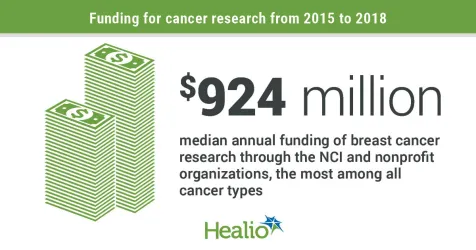By Josh Friedman
Key takeaways:
- Breast cancer received 25% of cancer funding from 2015 to 2018.
- Cancers with high mortality rates, such as colorectal and pancreatic cancer, are underfunded.
Cancer research and advocacy funding disproportionately skewed toward certain subtypes, leaving many cancers with high mortality rates and those affecting Black patients underfunded, study results in JCO Oncology Practice showed.
NCI and high-revenue, cancer-related nonprofit organizations (NPOs) donated $13.66 billion to cancer research between 2015 and 2018, but funding for the three cancers with the most deaths — lung, colorectal and pancreatic — did not combine to equal that of breast cancer, which ranked fourth in mean annual mortality rate.

“No disease is more important than the other, but clearly the dollars really don’t replicate that at all,” Suneel D. Kamath, MD, a medical oncologist at Cleveland Clinic, told Healio. “Even though people feel there’s equality, there’s actually no equality at all in terms of how much we fund some [cancers] or the other.”
Breaking down the numbers
Kamath and colleagues broke down funding distribution into 12 different cancer types from NCI and NPOs with at least $5 million in revenue for their research.
Of the 37 NPOs that met the criteria, breast cancer had 13 benefactors, lung cancer and leukemia had four each, prostate and ovarian cancer had three apiece, and seven others had one or two.
Breast cancer, which had the highest incidence of all cancers during the study period, brought in more than 25% of all funding ($3.74 billion) between NCI and NPOs, with a median value of more than $920 million annually.
“The sheer magnitude of those dollars was just tremendous,” Kamath said.
Leukemia ($1.99 billion; eighth in incidence; seventh in mortality), lung cancer ($1.59 billion; second in incidence; first in mortality), lymphoma ($1.299 billion; sixth in incidence; eighth in mortality) and prostate cancer ($1.21 billion; third in incidence; sixth in mortality) all eclipsed $1 billion in funding as well.
Colorectal cancer — second in mortality — received the sixth most funding. Meanwhile, pancreatic cancer received the seventh highest funding while ranking third in mortality (third in mortality). Researchers reported a similar disparity for liver and bile duct cancer, which ranked fifth in mortality and had the tenth most funding.
“Based on incidence, we fund things relatively well, which makes sense. Things that are more common should get more dollars,” Kamath said. “But what’s really lagging is that, paradoxically, the diseases where we have the least efficacy and the least ability to treat — the ones that have the highest mortality rates — are the ones we’re funding the least.”
Researchers also determined white patients benefitted from funding more than Black patients.
“Roughly every 80 cents on the dollar that’s going to diseases that affect white patients is closer to 50 or 60 [cents] for diseases that more affect those in the Black community,” Kamath said.
Additionally, the number of clinical trials for a specific cancer had a direct association with the amount of funding.
“That’s not particularly surprising, it makes perfect sense, but if you really think about it, a lot of NCI funding is not directly for clinical trials,” Kamath said. “Most of it goes toward lab-based science, working on cell lines or animal models. I was very surprised at how tight that relationship was that dollars at any single time really do correlate. If you do the science to understand pathways of certain diseases, that will pay off later with newer drugs that eventually make it in the clinical trials.”
Looking forward
Kamath noted not much can be done regarding NPOs. Those organizations and their leaders have specific connections or reasons for donating to certain cancers, and that won’t change.
NCI funding is different, he said.
“We have this pot of money that we’re given by Congress — are we using things like incidence and mortality and the cost of care for that disease [to determine funding?” Kamath asked. “Does it affect young people? Does it affect people that are underserved? These are all criteria and factors to me that I think any society would say, yes, we should consider these and make our appropriation decisions based on these metrics, and it’s obvious to me that that is definitely not happening now.”
Spreading funding around could also diversify talent across cancer types.
“Think about if you’re a junior faculty just finishing fellowship or medical school, and you’re looking to get a career in science and academic medicine,” Kamath said.
“Obviously, the first thing you need is funding for your research. If you create this environment where you’re constantly fighting tooth and nail for dollars that are open to all tumor types, you’re only going to get a small subset of that pool,” he added. “But, if you have an environment like what happens with breast cancer, leukemia, lymphoma — where there are a lot of specific grant opportunities for those individual diseases — that’s a lot more attractive. Your chance of success in that type of career is much greater.”
Kamath feels the FDA could play a role in helping narrow gaps, specifically by giving accelerated approvals for the deadliest diseases.
“I’ve talked to people that are in relatively higher levels of pharmaceutical companies, and they all say accelerated approval can get your drug to market 6 months earlier sometimes than the standard process,” he said. “Each of those months could be (millions in profit). If it were easier for diseases with the highest mortality rates, the ones that were the most underfunded, to get these designations, I think pharma would react to that, and we might start to see more dollars flow in the directions that we need them to go.”
For more information:
Suneel D. Kamath, MD, can be reached at kamaths@ccf.org.

